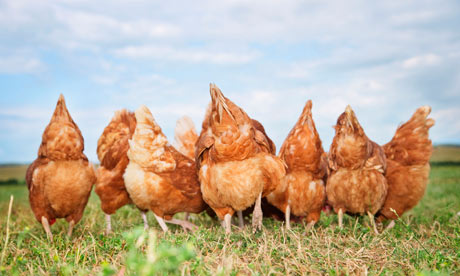 Keeping Chickens At Home - Choosing The Right Chicken Coop Or Hen House
Keeping Chickens At Home - Choosing The Right Chicken Coop Or Hen HouseOften the price looks attractive, the house looks attractive, heck even the clean-wellied family standing there feeding the chickens look attractive. Surely they know a quality chicken house when they see one? There are many cheap and nasty coops flooding the market. I know this as I've tested a number of them in the field, and seen a ewe run straight through one when the feed bucket appeared. The result was nothing but an expensive pile of firewood and a small flock of bemused and now homeless bantams.
More often than not these mass produced models are constructed of fast grown timber - come the first drop of rain they swell, leaving you either barricading a door that won't close, or ripping the door furniture off in a vain attempt to release the squawking inhabitants. The first warm day means the timber dries and cracks, the felt roof bubbles and boils, and come nightfall the hens refuse to go in. This is not due to their disappointment at the decline of their once attractive property but because the hovel is now a haven for, and probably crawling with, the poultry keeper's nemesis, red mite. Add on the fact that it said on the blurb that it would suit four large hens when that stocking density was based on the Circle Line at 5pm on a Friday, and what are you left with? A couple of hinges and some kindling.
A decent coop for thee to four birds should cost you in the region of £150 though this can depend on whether you elect for a free standing house or one with a run attached. Assuming you are ranging your birds in a large space and the pop hole door is big enough for the breed you keep, then the main requirements of housing boil down to three points which will define the number of birds the house will hold; perches, nest boxes and ventilation.
Raising Chickens - Keeping Chickens
Most breeds of chicken will perch when they go to roost at night, this perch should ideally be 5-8cm wide with smoothed off edges so the foot sits comfortably on it. The perch should be higher than the nest box entry as chickens will also naturally look for the highest point to perch. A perch lower than that will have the birds roosting in the nest box overnight (which is incidentally when they produce the most poo) leading to soiled eggs the following day. They shouldn't however be so high off the floor of the house that leg injuries could occur when the bird gets down in the morning. Chickens need about 20cm of perch each (in small breeds this is obviously less), plus if more than one perch is installed in the house they should be more than 30cm apart. They will hunker up with their neighbours but are not that keen on roosting with a beak in the bloomers of the bird in front.
Ideally the house should have a least one nest box for every three birds and these should be off the ground and in the darkest area of the house. The house should have adequate ventilation: without it condensation will build up every night, even in the coldest of weather. Be aware, ventilation works on the principle of warm air leaving through a high gap drawing cooler air in from a lower gap - it's not a set of holes on opposite walls of the house and at the same level...that is what's known as a draught ;)
If you have a house with a run attached then the points above are still true, but you should also consider the run size. The EU maximum legal stocking density for a free range bird is (and let's face it, one of the motivations for keeping some hens at home is possibly improved or better welfare) 2,500 birds per hectare, that's maximum one bird per 4m squared. Take a close look at some of the bargain houses - it could well be the house has the right perches, correct ventilation and ample nest boxes for a reasonable number of birds, but will each of the chickens have anything more than an A4 sized piece of ground to spend the day on?
Basically give your ladies as much space as you can manage. Your chickens will thank you for it :)
Raising Chickens - Keeping Chickens